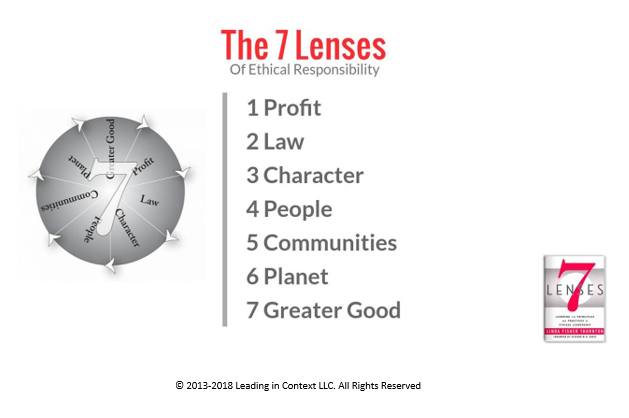
By Linda Fisher Thornton
Ethical leadership is not a position or a task. It is a complex array of roles, relationships and processes, and yet we use one term, “ethical leadership,” to talk about it. And in using that term, we often mean different things.
What Then is Ethical Leadership?
Why has it been so difficult for researchers to agree on a single definition of ‘ethical leadership?’ Here are some important reasons:
- Our understanding of responsible leadership depends on where we are in our own moral development
- People are writing about it from many different perspectives and using many different words to describe it
- In leadership competence there are many possible combinations
By “many possible combinations,” I am referring to the reality that leaders are not all competent in all aspects of ethical leadership and they vary in which areas they have mastered. A leader might excel at following laws, for example, but not know how to work well with diverse groups of people. Or a leader could be great at making a short-term profit, but not good at thinking long term and protecting the planet.
A Developmental Definition
Leadership is a changing process. It is difficult to define it because as the world changes, our understanding of what it means to lead responsibly in that world changes. Because it is a changing process, it is best viewed from a developmental perspective.
Leaders need to tackle complexity directly. Oversimplified approaches to complex problems lead to high profile ethical failures.
Leaders need a way to understand their own learning and development that helps them keep up with increasing ethical expectations. The developmental model outlined in by book 7 Lenses (now in its 2nd printing) frames “ethical leadership” as a developmental continuum based on these assumptions:
- People grow
- People’s understanding of leadership responsibility grows as they learn and develop as human beings
- The way that people view life and reality will impact their leadership philosophy
- Times change
- The standards for acceptable behavior and leadership evolve as times change
- The world is complex and connected
- The complexity and connections raise the stakes on us as leaders and require us to think using a higher level of complexity
- Thinking at a higher level of complexity means we can consider more constituents and more variables when making decisions
Some ways of interpreting “ethical leadership” are more responsible than others. If we are going to use the term “ethical leadership” to refer to an entire spectrum of developmental levels, we will need a way to talk about the nuances of ethical competence. Applying the 7 Lenses model gives us a way to talk about those nuances. Here are two examples:
- If a leader is interpersonally toxic in the workplace, but devoted to community service and environmental protection, that leader is not leading through Lens 4 (People) but is leading through Lens 5 (Communities) and Lens 6 (Planet).
- If a leader is divisive and only respectful to certain people or groups, that leader is not leading through Lens 3 (Character) or Lens 4 (People), but the same leader could be great at managing Profit (Lens 1).
Regardless of level or title, the most competent ethical leaders make it a priority to learn and they struggle to stay competent in all 7 dimensions of ethical responsibility as the world changes.
How will this developmental model help you talk about the nuances of ethical leadership?
Special 5 Post Series Celebrating the Second Printing of 7 Lenses:
Why Ethical Thinking Matters (Part 1)
Why Ethical Thinking Matters (Part 2)
Why Ethical Thinking Matters (Part 3)
Why Ethical Thinking Matters (Part 4)
Why Ethical Thinking Matters (Part 5)
© 2018 Leading in Context LLC


